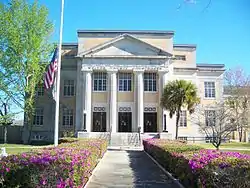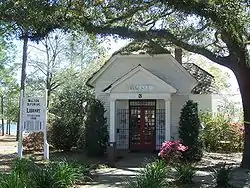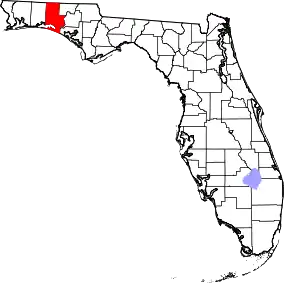DeFuniak Springs, Florida | |
|---|---|
| City of DeFuniak Springs | |
 | |
| Motto(s): "Partnership, Planning, And Preservation" | |
 Location in Walton County and the state of Florida | |
| Coordinates: 30°43′N 86°7′W / 30.717°N 86.117°W | |
| Country | United States of America |
| State | Florida |
| County | Walton |
| Incorporated | 1901 |
| Government | |
| • Type | Council–Manager |
| • Mayor | Bob Campbell |
| • Mayor Pro Tem | Todd Bierbaum |
| • Council Members | Josh Sconiers, Amy Heavilin, Anthony Vallee, and Henry Ennis, Sr. |
| • City Manager | Michael Barker |
| Area | |
| • Total | 14.30 sq mi (37.03 km2) |
| • Land | 13.95 sq mi (36.13 km2) |
| • Water | 0.35 sq mi (0.90 km2) |
| Elevation | 259 ft (79 m) |
| Population (2020) | |
| • Total | 5,919 |
| • Density | 424.30/sq mi (163.82/km2) |
| Time zone | UTC-6 (Central (CST)) |
| • Summer (DST) | UTC-5 (CDT) |
| ZIP codes | 32433, 32435 |
| Area code(s) | 850, 448 |
| FIPS code | 12-16800[2] |
| GNIS feature ID | 0294592[3] |
| Website | http://www.defuniaksprings.net |
DeFuniak Springs is a city and the county seat of Walton County, Florida, United States. The population was 6,968 as of the 2020 Census. DeFuniak Springs also serves as a hub for many residents in surrounding communities. In 2019, MSN's Insider Online named the city as the "best small town in Florida".[4]
DeFuniak Springs is home to Lake DeFuniak, one of two spring-fed lakes in the world that is nearly perfectly round.
History

The town was founded during the late 19th century as a resort development by the officers of the Pensacola and Atlantic Railroad, a subsidiary of the Louisville and Nashville Railroad. The P&A was organized to connect the terminus of the L&N at Pensacola to the western terminus of a predecessor of the Seaboard Air Line Railroad at River Junction—now Chattahoochee—in the 1880s. The town was named after Frederick R. De Funiak,[5] a vice-president of the L&N. Like much of Northwest Florida, DeFuniak Springs was settled mainly by Scots from Virginia and the Carolinas.
DeFuniak Springs was established as a final-destination resort. The developers enlisted the cooperation and aid of the Chautauqua Movement. The Chautauqua Hall of Brotherhood, an auditorium seating 4,000, was constructed on Lake DeFuniak in the center of town. Seminars, classes, and the like were held in the Hall of Brotherhood building for people on vacation.
The auditorium of the building was severely damaged by Hurricane Eloise in 1975 and razed. In 2003, the Chautauqua Hall of Brotherhood Foundation, Inc., a charitable foundation, started a capital campaign to restore the historic building.[6] The westerly portion of the building facing Circle Drive was still in use at that time.
As part of the intellectual atmosphere of the town, a college and a private high school (named Palmer College and Palmer Academy, respectively), as well as a technical school (Thomas Industrial Institute) and a teacher training school (Florida Normal College) were established in the late 19th century. Florida Normal College was later incorporated into Florida State University. The other schools closed during the Great Depression, which created financial strains. There remains a College Avenue that once led to Palmer College.
In 1886, the town held an important meeting that changed the course of public education in Florida. At this meeting, teachers from around the state formed the Florida Education Association. This teachers' union remains the state's predominant voice for educators and is affiliated with the National Education Association and the American Federation of Teachers.
The town contains other historically significant landmarks. The Walton County Library is located on Circle Drive, the oldest extant library in the state of Florida.[7] The library contains antiquities, including an impressive medieval weapon collection, in addition to many first-edition books. Also situated on Circle Drive are the Walton County Heritage Museum, housed in the former L&N railroad depot, and St. Agatha's Episcopal Church, built in 1895–1896.

First Presbyterian Church is the only private structure in the Lake Yard, the park surrounding the lake. Although Walton County was opposed to secession, the first monument to the Confederate war dead constructed in Florida is located on the lawn of the Walton County Courthouse.
A chicken processing plant operated by Perdue Farms at DeFuniak Springs was closed in April 2004.[8]
Traditions
The surrounding landscape of Lake DeFuniak is decorated for the holidays between Thanksgiving and New Year's Day to celebrate the holiday season. This is known to locals as the "Christmas Reflections".
Geography
DeFuniak Springs is located at 30°43'N 86°7'W (30.721, –86.119).[9]
The city is located in the Florida Panhandle along Interstate 10 and U.S. Routes 90 and 331. I-10 runs south of the city from west to east, providing access from exit 85 (U.S. Route 331). I-10 leads east 119 mi (192 km) to Tallahassee, the state capital, and west 80 mi (130 km) to Pensacola. U.S. Route 90 runs through the city from west to east as Nelson Avenue, and leads east 12 mi (19 km) to Ponce de Leon and west 29 mi (47 km) to Crestview. U.S. Route 331 is the main north–south route in the city and its main connection to the Gulf coast. U.S. 331 leads northwest 25 mi (40 km) to Florala, Alabama, and south 26 mi (42 km) to U.S. Route 98 near Santa Rosa Beach. Florida State Road 83 also runs through the city as well, leading south to Santa Rosa Beach (with U.S. 331) and north 19 mi (31 km) to the Florida-Alabama state line.
According to the United States Census Bureau, the city has a total area of 11.2 square miles (29 km2), of which 11.0 square miles (28 km2) is land, and 0.3 square miles (0.78 km2) (2.49%) is water.
Climate
DeFuniak Springs has a humid subtropical climate (Cfa) with abundant precipitation, particularly during the summer months, due to its location on the Gulf Coast and consequent vulnerability to tropical storms and hurricanes.
| Climate data for DeFuniak Springs 1 E, Florida, 1991–2020 normals, extremes 1896–2010 | |||||||||||||
|---|---|---|---|---|---|---|---|---|---|---|---|---|---|
| Month | Jan | Feb | Mar | Apr | May | Jun | Jul | Aug | Sep | Oct | Nov | Dec | Year |
| Record high °F (°C) | 84 (29) |
86 (30) |
91 (33) |
97 (36) |
102 (39) |
107 (42) |
105 (41) |
104 (40) |
104 (40) |
98 (37) |
92 (33) |
89 (32) |
107 (42) |
| Mean daily maximum °F (°C) | 62.3 (16.8) |
65.8 (18.8) |
72.7 (22.6) |
79.2 (26.2) |
86.4 (30.2) |
90.3 (32.4) |
92.3 (33.5) |
91.4 (33.0) |
88.3 (31.3) |
80.5 (26.9) |
71.3 (21.8) |
64.3 (17.9) |
78.7 (25.9) |
| Daily mean °F (°C) | 50.9 (10.5) |
54.6 (12.6) |
60.4 (15.8) |
66.6 (19.2) |
74.8 (23.8) |
80.3 (26.8) |
82.4 (28.0) |
81.5 (27.5) |
77.8 (25.4) |
68.9 (20.5) |
58.9 (14.9) |
53.1 (11.7) |
67.5 (19.7) |
| Mean daily minimum °F (°C) | 39.5 (4.2) |
43.4 (6.3) |
48.0 (8.9) |
54.0 (12.2) |
63.1 (17.3) |
70.2 (21.2) |
72.4 (22.4) |
71.7 (22.1) |
67.4 (19.7) |
57.4 (14.1) |
46.6 (8.1) |
41.8 (5.4) |
56.3 (13.5) |
| Record low °F (°C) | 3 (−16) |
0 (−18) |
19 (−7) |
21 (−6) |
35 (2) |
43 (6) |
54 (12) |
55 (13) |
35 (2) |
28 (−2) |
16 (−9) |
5 (−15) |
0 (−18) |
| Average precipitation inches (mm) | 5.04 (128) |
5.07 (129) |
5.18 (132) |
4.30 (109) |
3.99 (101) |
7.10 (180) |
7.50 (191) |
6.95 (177) |
6.04 (153) |
3.58 (91) |
4.43 (113) |
5.45 (138) |
64.63 (1,642) |
| Average precipitation days (≥ 0.01 in) | 9.2 | 8.3 | 8.0 | 7.0 | 7.6 | 12.7 | 14.2 | 13.9 | 10.3 | 6.2 | 7.0 | 8.6 | 113.0 |
| Source: NOAA[10][11] | |||||||||||||
Education
Public schools
Public schools in Defuniak Springs are run by the Walton County School District.[12]
- Walton High School
- Walton Middle School
- Maude Saunders Elementary School
- Mossy Head Elementary School
- West DeFuniak Elementary School
- Walton Academy
Private schools
- First Christian Academy
Library
At the time of planning, the founders of DeFuniak Springs were interested in the adult education movement. For DeFuniak Springs, this movement did not only include the Chautauqua center, McCormick University and Academy, and the State Normal School, but also a community library.
In 1887, a group of women formed the Ladies Library Association, and their goal was to establish a library that would become the "little sister" to the Chautauqua center, university, and school.[13] The Ladies Library Association chose a plot of land adjacent to the Chautauqua center and signed a lease for ninety-nine years.[13] By the end of 1887, five years after the initial plan of the village, there was a community library; the Ladies Library Association's main goal of establishing a social library was complete. Initially, the library relied on book donations, but also purchased books from the Ladies Reading Club and a private book owner, J. L. Shearer.[13] The Ladies Library Association persisted and was able to maintain the library, books, and maintenance of the library for quite some time. However, by 1923, the Ladies Library Association was unable to continue to sustain the library and requested city funds, which the city took on gradually. It was not until the 1960s when the subscription fees were finally eliminated, and the county and city assumed total responsibility for its maintenance and collection development.[13] Today, the Walton-DeFuniak Library remains in use just as it did when it opened in 1887.
Demographics
| Census | Pop. | Note | %± |
|---|---|---|---|
| 1890 | 672 | — | |
| 1910 | 2,017 | — | |
| 1920 | 2,097 | 4.0% | |
| 1930 | 2,636 | 25.7% | |
| 1940 | 2,570 | −2.5% | |
| 1950 | 3,077 | 19.7% | |
| 1960 | 5,282 | 71.7% | |
| 1970 | 4,966 | −6.0% | |
| 1980 | 5,563 | 12.0% | |
| 1990 | 5,120 | −8.0% | |
| 2000 | 5,089 | −0.6% | |
| 2010 | 5,177 | 1.7% | |
| 2020 | 5,919 | 14.3% | |
| U.S. Decennial Census[14] | |||
2010 and 2020 census
| Race | Pop 2010[15] | Pop 2020[16] | % 2010 | % 2020 |
|---|---|---|---|---|
| White (NH) | 3,555 | 3,753 | 68.67% | 63.41% |
| Black or African American (NH) | 1,045 | 996 | 20.19% | 16.83% |
| Native American or Alaska Native (NH) | 34 | 26 | 0.66% | 0.44% |
| Asian (NH) | 33 | 54 | 0.64% | 0.91% |
| Pacific Islander or Native Hawaiian (NH) | 3 | 2 | 0.06% | 0.03% |
| Some other race (NH) | 7 | 40 | 0.14% | 0.68% |
| Two or more races/Multiracial (NH) | 113 | 393 | 2.18% | 6.64% |
| Hispanic or Latino (any race) | 387 | 655 | 7.48% | 11.07% |
| Total | 5,177 | 5,919 | ||
As of the 2020 United States census, there were 5,919 people, 2,848 households, and 1,789 families residing in the city.[17]
As of the 2010 United States census, there were 5,177 people, 2,306 households, and 1,287 families residing in the city.[18]
2000 census
As of the census[2] of 2000, there were 5,089 people, 2,105 households, and 1,324 families residing in the city. The population density was 464.0 inhabitants per square mile (179.2/km2). There were 2,464 housing units at an average density of 224.7 per square mile (86.8/km2). The racial makeup of the city was 71.78% White, 22.99% African American, 1.00% Native American, 0.51% Asian, 0.08% Pacific Islander, 1.81% from other races, and 1.83% from two or more races. Hispanic or Latino of any race were 3.30% of the population.
In 2000, there were 2,105 households, out of which 27.4% had children under the age of 18 living with them, 40.7% were married couples living together, 18.4% had a female householder with no husband present, and 37.1% were non-families. 33.5% of all households were made up of individuals, and 16.2% had someone living alone who was 65 years of age or older. The average household size was 2.30, and the average family size was 2.91.
In 2000, in the city, the population was spread out, with 23.6% under the age of 18, 8.6% from 18 to 24, 24.4% from 25 to 44, 22.2% from 45 to 64, and 21.2% who were 65 years of age or older. The median age was 40 years. For every 100 females, there were 84.9 males. For every 100 females age 18 and over, there were 78.7 males.
In 2000, the median income for a household in the city was $24,516, and the median income for a family was $28,750. Males had a median income of $24,219 versus $19,255 for females. The per capita income for the city was $13,298. About 18.2% of families and 18.4% of the population were below the poverty line, including 27.6% of those under age 18 and 9.3% of those age 65 or over.
Gallery
 A caboose outside the old L&N railroad depot, now the Walton County Heritage Museum
A caboose outside the old L&N railroad depot, now the Walton County Heritage Museum The Chautauqua Hall of Brotherhood is the centerpiece of Circle Drive.
The Chautauqua Hall of Brotherhood is the centerpiece of Circle Drive. This home, built in the 1980s after the historic house on site burned, is in keeping with the older historic homes surrounding Lake DeFuniak.
This home, built in the 1980s after the historic house on site burned, is in keeping with the older historic homes surrounding Lake DeFuniak. Winter sunset on Lake DeFuniak, located in downtown DeFuniak Springs
Winter sunset on Lake DeFuniak, located in downtown DeFuniak Springs Lake DeFuniak in the daytime, from behind the Chautauqua Hall of Brotherhood
Lake DeFuniak in the daytime, from behind the Chautauqua Hall of Brotherhood The Walton-DeFuniak Library. Built in 1886–1887, it is the oldest structure in Florida built as a library and still serving as one.
The Walton-DeFuniak Library. Built in 1886–1887, it is the oldest structure in Florida built as a library and still serving as one. Sun Bright, the home of Sidney Johnston Catts, Florida's 22nd governor
Sun Bright, the home of Sidney Johnston Catts, Florida's 22nd governor One of the historic homes in the city's historic district
One of the historic homes in the city's historic district
Notable people
- Buck Showalter, (b 1956) is a professional baseball manager for the New York Mets.
- Kyrsten Sinema, (b 1976) is a politician serving as the senior United States senator from Arizona .
See also
References
- ↑ "2020 U.S. Gazetteer Files". United States Census Bureau. Retrieved October 31, 2021.
- 1 2 "U.S. Census website". United States Census Bureau. Retrieved January 31, 2008.
- ↑ "US Board on Geographic Names". United States Geological Survey. October 25, 2007. Retrieved January 31, 2008.
- ↑ DeFuniak named best small town in Florida, Daily News, January 2, 2019
- ↑ Washington, Ray (June 27, 1982). "The early railroad made West Florida". Ocala Star-Banner. pp. 7F. Retrieved June 7, 2015.
- ↑ "Chautauqua Hall of Brotherhood Foundation Inc". Archived from the original on December 1, 2005. Retrieved July 20, 2019.
- ↑ Blazek, R. (1987). "The Library, the Chautauqua, and the Railroads in DeFuniak Springs". The Journal of Library History, 22(4), 377-396.
- ↑ Fort Walton Beach, Florida, "Today in Local History", Northwest Florida Daily News,Friday 17 April 2015, Volume 69, page A5.
- ↑ "US Gazetteer files: 2010, 2000, and 1990". United States Census Bureau. February 12, 2011. Retrieved April 23, 2011.
- ↑ "NOWData - NOAA Online Weather Data". National Oceanic and Atmospheric Administration. Retrieved June 25, 2021.
- ↑ "Summary of Monthly Normals 1991-2020". National Oceanic and Atmospheric Administration. Retrieved June 25, 2021.
- ↑ "Walton County School District". Retrieved March 2, 2019.
- 1 2 3 4 Blazek, R. (1987). "The library, the chautauqua, and the railroads in DeFuniak Springs, Florida". The Journal of Library History. 22 (4): 377–396.
- ↑ "Census of Population and Housing". Census.gov. Retrieved June 4, 2015.
- ↑ "P2 HISPANIC OR LATINO, AND NOT HISPANIC OR LATINO BY RACE - 2010: DEC Redistricting Data (PL 94-171) - DeFuniak Springs city, Florida". United States Census Bureau.
- ↑ "P2 HISPANIC OR LATINO, AND NOT HISPANIC OR LATINO BY RACE - 2020: DEC Redistricting Data (PL 94-171) - DeFuniak Springs city, Florida". United States Census Bureau.
- ↑ "S1101 HOUSEHOLDS AND FAMILIES - 2020: DeFuniak Springs city, Florida". United States Census Bureau.
- ↑ "S1101 HOUSEHOLDS AND FAMILIES - 2010: DeFuniak Springs city, Florida". United States Census Bureau.
External links
- DeFuniak Herald newspaper that serves DeFuniak Springs, Florida is available in full-text with images in Florida Digital Newspaper Library
